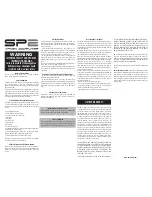
CHAPTER 1: THREE-PHASE POWER MEASUREMENT
BLONDEL’S THEOREM AND THREE PHASE MEASUREMENT
EPM 2200 POWER METER – INSTRUCTION MANUAL
1–5
The theorem may be stated more simply, in modern language:
In a system of N conductors, N-1 meter elements will measure the power or energy
taken provided that all the potential coils have a common tie to the conductor in
which there is no current coil.
Three-phase power measurement is accomplished by measuring the three individual
phases and adding them together to obtain the total three phase value. In older
analog meters, this measurement was accomplished using up to three separate
elements. Each element combined the single-phase voltage and current to produce a
torque on the meter disk. All three elements were arranged around the disk so that the
disk was subjected to the combined torque of the three elements. As a result the disk
would turn at a higher speed and register power supplied by each of the three wires.
According to Blondel's Theorem, it was possible to reduce the number of elements
under certain conditions. For example, a three-phase, three-wire delta system could
be correctly measured with two elements (two potential coils and two current coils) if
the potential coils were connected between the three phases with one phase in
common.
In a three-phase, four-wire wye system it is necessary to use three elements. Three
voltage coils are connected between the three phases and the common neutral
conductor. A current coil is required in each of the three phases.
In modern digital meters, Blondel's Theorem is still applied to obtain proper
metering. The difference in modern meters is that the digital meter measures each
phase voltage and current and calculates the single-phase power for each phase. The
meter then sums the three phase powers to a single three-phase reading.
Some digital meters measure the individual phase power values one phase at a time.
This means the meter samples the voltage and current on one phase and calculates a
power value. Then it samples the second phase and calculates the power for the
second phase. Finally, it samples the third phase and calculates that phase power.
After sampling all three phases, the meter adds the three readings to create the
equivalent three-phase power value. Using mathematical averaging techniques, this
method can derive a quite accurate measurement of three-phase power.
More advanced meters actually sample all three phases of voltage and current
simultaneously and calculate the individual phase and three-phase power values. The
advantage of simultaneous sampling is the reduction of error introduced due to the
difference in time when the samples were taken.
Содержание Multilin EPM 2200
Страница 30: ...2 10 EPM 2200 POWER METER INSTRUCTION MANUAL ACCURACY CHAPTER 2 OVERVIEW AND SPECIFICATIONS ...
Страница 54: ...4 20 EPM 2200 POWER METER INSTRUCTION MANUAL ELECTRICAL CONNECTION DIAGRAMS CHAPTER 4 ELECTRICAL INSTALLATION ...
Страница 82: ...6 24 EPM 2200 POWER METER INSTRUCTION MANUAL GE COMMUNICATOR PROGRAMMING OVERVIEW CHAPTER 6 USING THE METER ...
Страница 104: ...A 6 EPM 2200 POWER METER INSTRUCTION MANUAL NAVIGATION MAPS SHEETS 1 TO 4 APPENDIX A EPM 2200 NAVIGATION MAPS ...











































